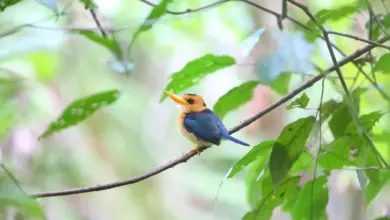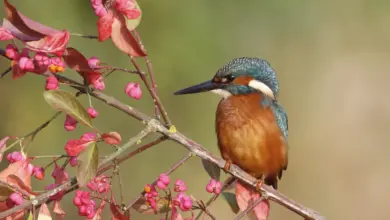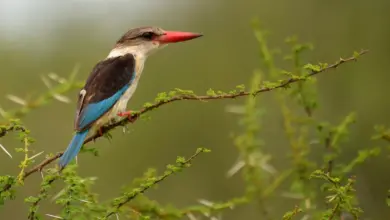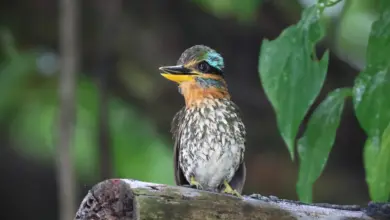The Kingfishers group belongs in the order Coraciiformes. There has been some confusion over the families within the order due to the changes made to the previous taxonomy listings during the 1990’s.
Originally considered to all be in the same family, Alcedinidae, the ninety species are now considered in the suborder Alcedines.
The Kingfisher Group is divided into three families:
- Alcedinidae, the River Kingfishers
- Halcyonidae, the Tree Kingfishers
- Cerylidae, the Water Kingfishers
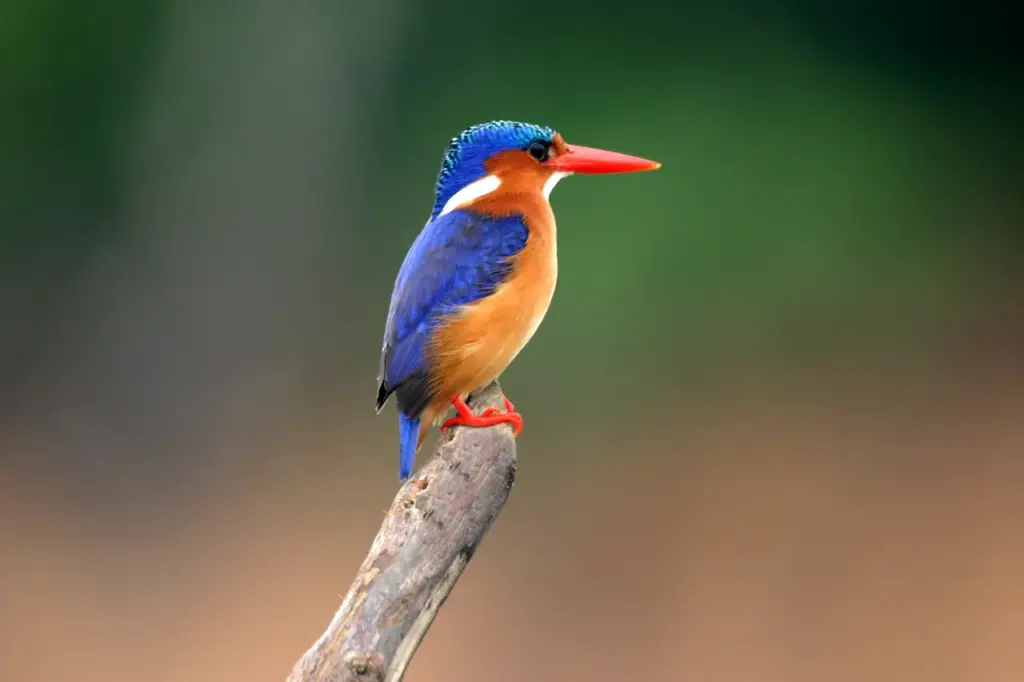
Distribution / Range
These magnificently marked, small to medium-sized birds have an international distribution with the majority of the species inhabiting the Old World (Europe, Africa and Asia) and Australia.
Quite a few species dwell on the South and East Pacific Ocean islands.
The Old World tropics and Australasia include the greatest and most centralized body of Kingfishers.
Only the Common Kingfisher, the Belted Kingfisher, and a few other localized species inhabit North America (north of Mexico) and Europe.
These include the Ringed Kingfisher and Green Kingfisher in the Southwest USA and the Pied Kingfisher and White-throated Kingfisher in Southeast Europe.
The Americas provide habitation for four green Kingfishers, all in the genus Chloroceryle. Two large-crested Kingfishers are in the genus Megaceryle. There are five South American Kingfishers species, six if you take into account the Belted Kingfisher which winters over in tropical areas there.
In the Gambia in Africa, however, the species claim huge ranges of territory. The Common Kingfisher can be seen from Ireland across Europe, North Africa and Asia and as far as the Solomon Islands in Australasia.
The Pied Kingfisher inhabits multiple areas across Africa and Asia.
Then there are those species which reside in far narrower ranges, especially if they are endemic to that area, such as the Kofiau Paradise Kingfisher, which is only found on the tiny island of Kofiau, off the coast of New Guinea.
Habitat
Kingfishers call a wide variety of habitats their homes. The majority of the species prefer to inhabit the tropical and temperate zones, and of those, nearly all live solely in forested areas. Kingfishers are not to be found in frigid climates.
Most people think of Kingfishers as living only near rivers and large bodies of water, but more than half of the species in the world reside in forests and wooded areas near streams.
Only one species can be found in a dry desert: the Red-backed Kingfisher of Australia. Some species reside high in the mountains and some in open woodland.
Many prefer to occupy tropical coral atolls (a coral island which surrounds a lagoon).
Quite a few species now dwell near humans, having adapted to both urban and rural habitats. They can be found in woodlands, farmland, parks and gardens.
Description
The smallest species of Kingfisher is the African Dwarf Kingfisher (Ispidina lecontei), whose averages weight is 10.4 g and length is 10 cm (4 inches). The largest overall is the Giant Kingfisher (Megaceryle maxima) with an average weight of 355 g (13.5 oz) and average length is 45 cm (18 inches).
However, the Laughing Kookaburra may be the heaviest species, since large individuals may exceed 450 g (1 lb).
Nearly all Kingfishers possess bright, vibrant plumage, with blue and green being the colors most often observed.
The feathers can be turquoise, red, or gold. One would expect these vivid markings and dazzling colors to be a result of pigmentation, but the brightness of the colors is neither the product of the iridescent refraction of light waves (except in the American Kingfishers) or pigmentation, but instead is the result of the feathers’ structure, which causes the scattering of blue light, known as the “Tyndall effect.”
There is little difference in the markings between the sexes.
Their bodies are unusually configured. All Kingfishers are known for their stocky bodies, large heads and long, thick, sharply pointed bills, shaped like a dagger.
In those species which dive for fish, the bill is generally longer and more compressed; in those which hunt for prey on land, it is shorter and broader.
The bill seems disproportionate to the rest of the body, but it is designed for impaling and capturing its prey. Their legs are short and their tails broad and stout. Their strong feet support them while perching on branches.
Diet / Feeding
The majority of the Kingfisher species have well developed vision. Their dark brown eyes are able to see colors distinctly and are even capable of binocular vision.
They are able to move their eyes within the eye sockets rather than having to rotate their entire heads to follow their prey. An unusual adaptation they possess is the ability to compensate for the water’s refraction and reflection as they search for prey underwater.
This makes the fish look closer to the surface than it is. They have accurate depth perception as well. Nature has provided the Kingfisher with a great deal of ocular protection.
Their nictitating membranes protect their eyes when they hit the water. One species, the Pied Kingfisher, has a unique adaptation: a bony plate which slides across the eye when the bird hits the water.
The Kingfisher will stab its prey, either with the bill closed or open, depending on the size of the prey. Kingfishers of all three families kill their prey by beating them on the ground or perch to shatter the bones.
Then they work the fish into their mouths, head first, so that they won’t get cut up by the bones or scales as they swallow it whole. They will even consume snakes in this manner!
Many Kingfishers can eat prey that seems too large to fit in their mouths. Some species feed primarily on fish, frogs, crustaceans, crabs, crayfish, worms, mollusks, insects, spiders, centipedes, reptiles and even birds and mammals.
Depending on the location the species inhabit, their diets will differ. Woodland and forest Kingfishers feed mainly on insects, especially enjoying grasshoppers, whereas those which dwell near water feed on amphibious prey.
Breeding / Nesting
The Kingfishers are cavity-nesters. They create tunnels by digging into the ground on the banks of the waterways. They will nest, not only in these natural earthen banks, but in man-made ditches as well.
All Coraciiformes are known to nest in this manner. The nests of forest-dwelling species are found in holes in trees, the ground at the roots of uprooted trees, or even in abandoned arboreal termite nests (termitaria), commonplace in forests.
The nests are constructed by both males and females. They will take turns burrowing out a tunnel with their feet, and then they will hollow out a narrow chamber at the end of the tunnel in which to lay their eggs.
The birds will spend between three and seven days working to complete their tunnel. Some birds attack their worksites so forcefully that they have fatally injured themselves as they fly into the tunnels during these excavations.
The tunnels of the various species will reach different lengths, depending on their locations. If they burrow into termitarium nests, the tunnels will be shorter; nests built into the soil will be longer.
Nests constructed in hard, less penetrable ground will have tunnels that are shorter than those dug into sand or soft soil.
The Giant Kingfisher can boast of having built the longest tunnels on record, some measuring 8.5 meters long. Most tunnels are 3 to 6.5 feet long (1-2 meters). Kingfishers are fiercely territorial in defense of their nests. For the most part, they are monogamous, but some species will engage in cooperative breeding.
The nesting chamber can measure as much as 8-12 inches wide and 6-7 inches high. There, they lay their eggs and raise their chicks. The number of these white, glossy eggs depends on the species.
The larger and smaller species may lay only two eggs per clutch, whereas intermediate species may lay as many as 10 eggs. The average clutch contains three to six eggs, and both parents incubate the eggs.
The chicks grow quickly, but initially are altricial (relatively immobile, lack down and are completely helpless). They require feeding by the parents, who bring the food into the nesting chamber. But soon the chicks are able to travel toward the entrance of the tunnel where they encounter the adults and wait to be fed.
Eventually, they young are fed on a perch near the entrance. Fledging can last a few days to a few weeks. After that, they will be on their own and will feed themselves.
Habits
Kingfishers are highly territorial birds. They will locate a prime area based on food sources, desirable perching trees and safe roosting sites. Like most birds, they will search for their food in the mornings and evenings.
If the weather is cooler, they will also hunt for food during mid-day. Kingfishers utilize a variety of vocalizations. These calls are used to drive other birds from their region and to communicate with their mates and chicks.
These calls have been described as shrieks, screams, clicks, whistles, chuckles, rattles, and chirps.
These stocky birds are swift flyers. Some, like the Pied Kingfisher (Ceryle rudis), are able to hover over the water by flapping their wings rapidly. Cleanliness is important to Kingfishers; they will dive into the water to bathe, then fly to a perch to preen and dry their feathers in the sunlight.
Some will even clean their heads using their wings. They will utilize a branch to clean their impressive bills, keeping them in excellent condition by scraping them back and forth.
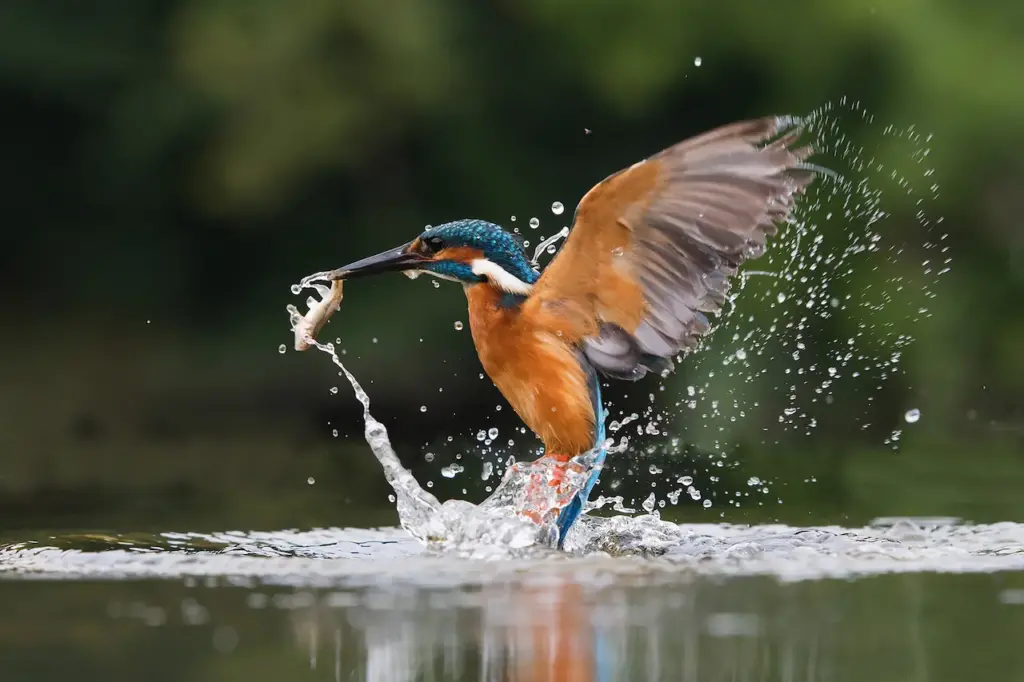
More commonly known Kingfisher species:
Common Kingfisher aka Eurasian Kingfisher or River Kingfisher
The seven subspecies of the Common Kingfisher claim a wide distribution across Europe, Asia and North Africa. They are also found in the Western Cape of South Africa. The nominate race is found in Italy.
Belted Kingfisher
The Belted Kingfisher is a large, noticeable water kingfisher. It is one of the two species that can be found in the northern United States and Canada and is one of only six species of Kingfisher found in the Americas.
Amazon Kingfisher
The Amazon Kingfisher resides in the tropical lowlands of Southern Mexico, Central America and Argentina. It is thought to inhabit parts of Texas as well.
Collard Kingfisher
The Collard Kingfisher inhabits the coastlines of Northern and Northeastern Australia. It prefers to live in mangroves and is, therefore, often referred to as the “Mangrove Kingfisher.”
Yellow-Billed Kingfisher
Like many Kingfishers which dwell in the forest, the Yellow-billed Kingfisher (Syma torotoro) often nests in abandoned arboreal termite nests. It is indigenous to Australia and can be found in the mangroves and rainforests of the northernmost part of Cape York. It also dwells in the lowlands of New Guinea and the adjacent islands, extending to Northern Cape York Peninsula in Australia.
Oriental Dwarf Kingfisher
The Oriental Dwarf Kingfisher’s territory encompasses a huge geographical area. It is endemic across much of Southeast Asia, South China and the Indian Subcontinent, and It can be found in Bangladesh, Bhutan, Brunei, Cambodia, India, Indonesia, Laos, Malaysia, Myanmar, Singapore, Sri Lanka, Thailand, and Vietnam.
Rufous-collared Kingfisher
The Rufous-collared Kingfisher is found in Brunei, Indonesia, Malaysia, Myanmar, Singapore and Thailand. Its natural habitats are subtropical or tropical wetlands in lowland forests and montanes (mountainous regions) with heavy rainfall.
It is considered endangered due to the rapid loss of its rainforest habitat.
Sacred Kingfisher
The Sacred Kingfishers inhabit most of Australia; they do not reside in the dry central deserts, however.
Sacred Kingfishers are also found in New Zealand, Lord Howe Island, Norfolk Island, New Guinea, Eastern Indonesia, much of Northern and Western Melanesia, and the Kermadec Islands. This species dwells in much of Australia (except the dry interior), New Zealand, New Caledonia and New Guinea for breeding purposes.
When breeding season is over, birds inhabiting the southern two-thirds of Australia travel north to New Guinea, east to the Eastern Solomon Islands and west to Indonesia. Very few migrate west as far as Sumatra.
They migrate south again to Australia in August or September. Occasionally it will travel to Christmas Island (in the Indian Ocean), Malaysia, the Marshall Islands, the Federated States of Micronesia, and Nauru.
Forest Kingfisher
The Forest Kingfisher (Todiramphus macleayii) is also known as the Macleay’s or Blue Kingfisher. It inhabits the coastal forests bordering the rivers and mangroves of Indonesia, New Guinea and coastal Eastern and Northern Australia.
It can also be seen in Papua New Guinea and the Solomon Islands.
In Australia, it is found on or near the Australian Coastline from Port Stephens in New South Wales, northwards to Cape York, and westwards across the Top End.
It the summer, is can be found in the southern parts of its range in New South Wales and southern Queensland; in the other countries, it is a permanent resident.
Buff Breasted (Paradise) Kingfisher
The Paradise Kingfisher is found only in the rainforests of Cape York, Australia. It resides there in the spring, during breeding season. After that, it migrates back to New Guinea or Indonesia for the remainder of the year.
Red-backed Kingfisher
The Red-backed Kingfisher (Todiramphas pyrrhopygius) can be found inhabiting most parts of Australia. Unlike other Kingfishers, it has been able to adapt to the harsher climate of Australia’s interior deserts.
The only areas it is does not inhabit are those which get a high amount of rain, such as the coastal areas of the Southwest, Southeast, East and Northeast.
It survives in eucalyptus woodlands, scrub and tussock grasslands (small areas of stiff, tufted grass that grow higher than the surrounding grasses). It also dwells in areas which have clusters of trees.
In the summer months, it can be found in the southeastern part of the country; elsewhere it is a year-round resident. It inhabits dry forests which contain mulga trees (an Australian acacia tree) and mallee trees (a shrubby eucalyptus tree) and savannahs (flat grassland with scattered trees, found in tropical or subtropical regions). It avoids denser forests.
Azure Kingfisher
The Azure Kingfisher’s habitat follows the Australian coastline from the top of the Northern Territory all the way down the east coast to and including Tasmania.
The species frequents rivers and streams, billabongs (small, stagnant lakes attached to waterways), lagoons and other bodies of water with low, overhanging branches.
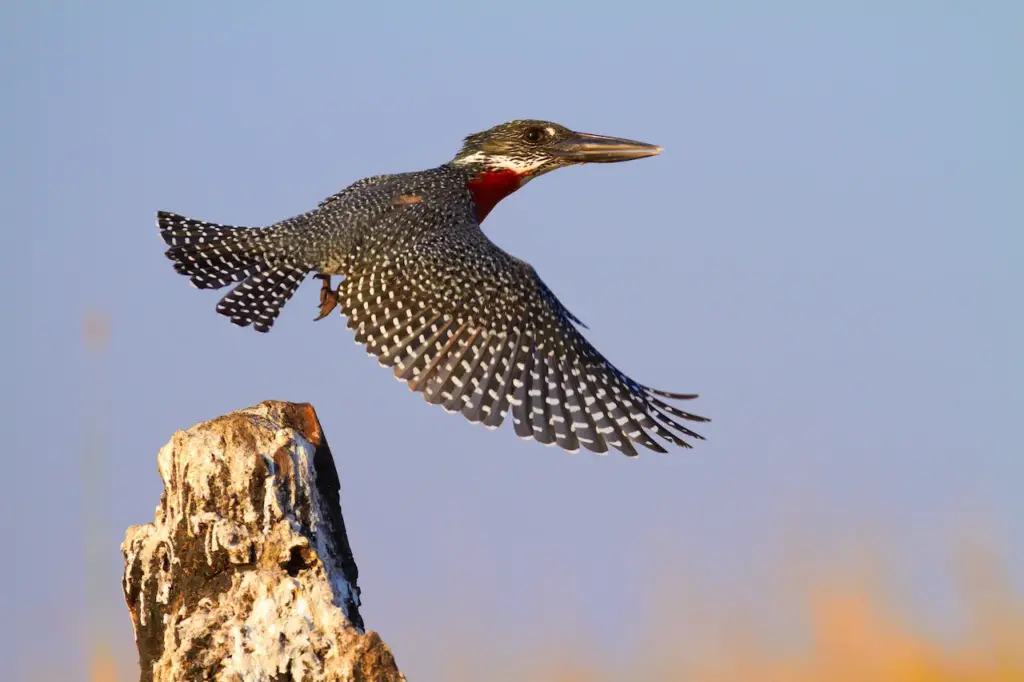
Little Kingfisher
In Australia, the Little Kingfisher has a narrow range—the northern coastal areas of Queensland and the Northern Territory. It also inhabits Indonesia, Papua New Guinea and the Solomon Islands.
It is found in rainforest pools, lakes, estuaries, open forest, swamps, mangroves, creeks, and other waterways.
The Little Kingfisher is a bird of lowland rainforest streams, preferring dark, narrow spaces with overhanging vegetation.
Beauty Of Birds strives to maintain accurate and up-to-date information; however, mistakes do happen. If you would like to correct or update any of the information, please contact us. THANK YOU!!!

